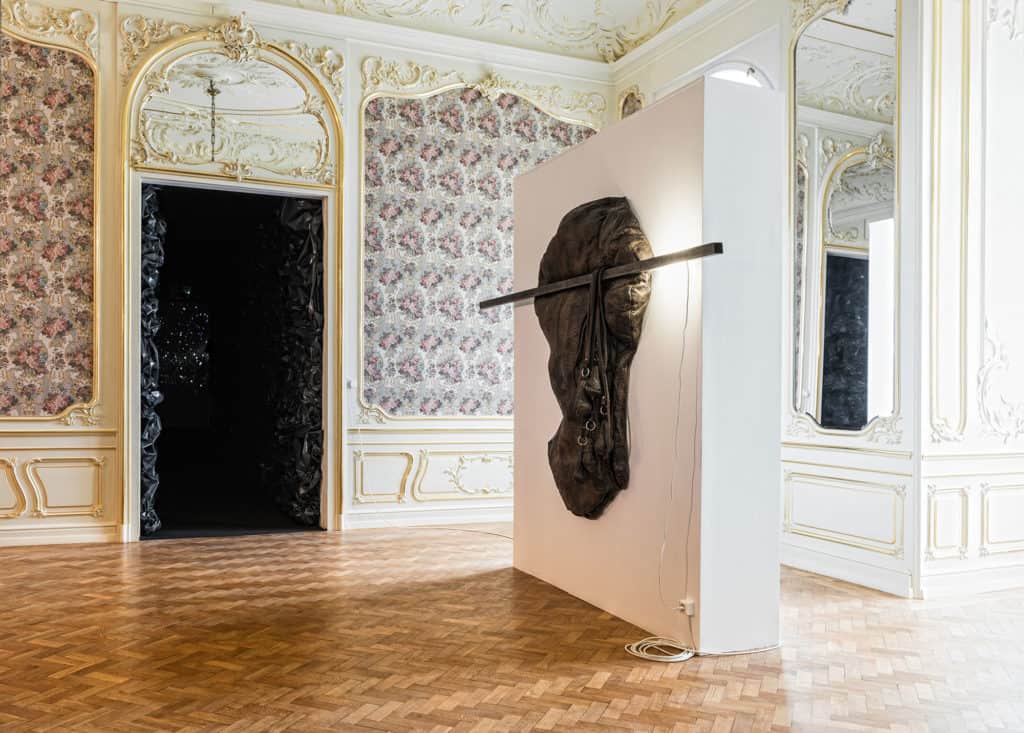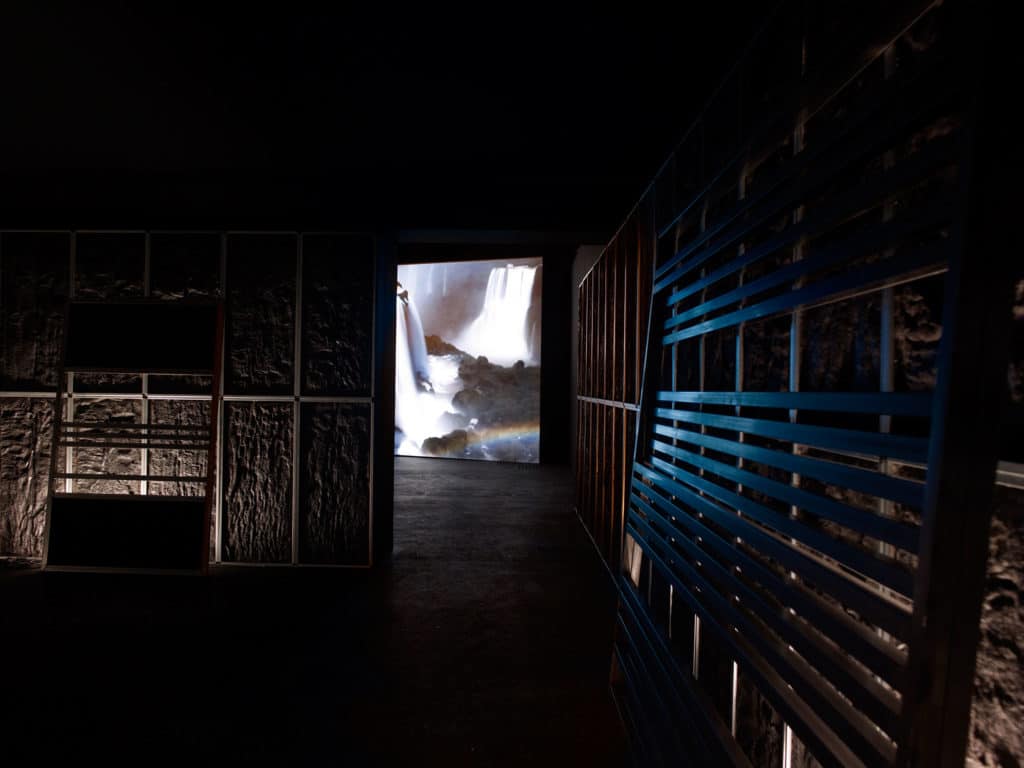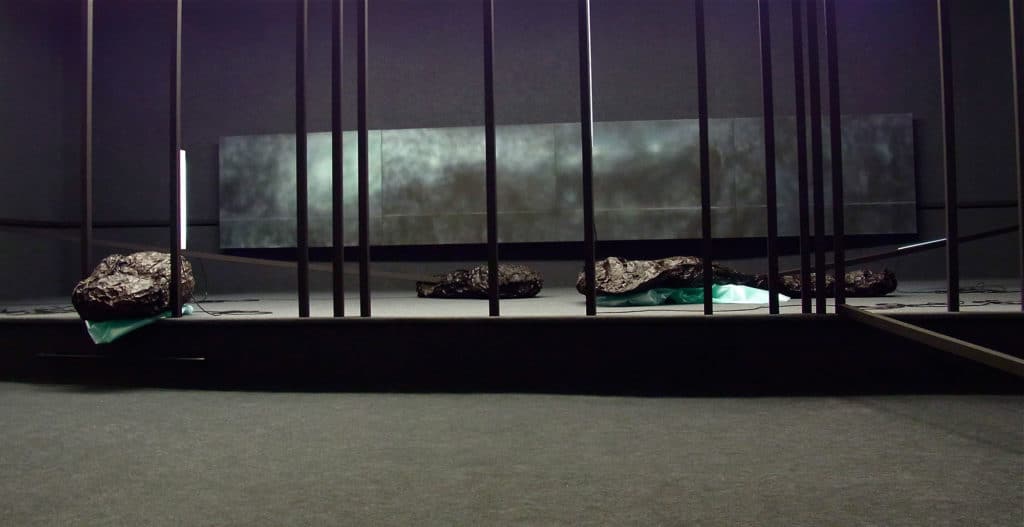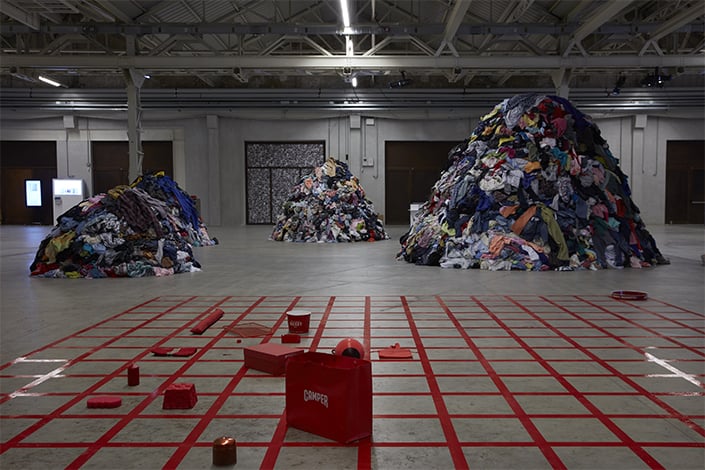Angelika Markul, Delprat Nicolas, ‘In the Middle of the Night’, 2012, Galeria Labirynt, Lublin, courtesy of the artist
Small, white-transparent, unobtrusive, yet not irrelevant among other 56 international works of art displayed, the installation Gone With the Wind (2016) by Angelika Markul was presented in Pirelli Hangar Bicocca in Milan between 1st November 2017 – 14th January 2018. The group exhibition entitled Take Me (I’m Yours) curated by Hans Ulrich Obrist, Christian Boltanski, Chiara Parisi and Roberta Tenconi took place in the enormous, contemporary art space in Milan, in the very heart of Northern Italy. The gallery is commonly known to be in the constant search for novelty and so are curator’s ideas.

Angelika Markul, Take Me I’m Yours, Pirelli Hangar Bicocca, Milano, photo Agostino Osio, courtesy of the artist
This time, visitors were faced with the slightly rebellious curatorial concept, as for the rather consumerist European artworld. Guests were invited not only to take home, but also play with and bring to the exhibition their own pieces of art to add them to the already exposed set of artworks. And this game was not only for funny players – Christian Boltanski, Félix González-Torres, Bruce Nauman, Wolfgang Tillmans, Douglas Gordon, Carsten Höller – to mention only a few, are nothing about insignificant gestures. And so is not Angelika Markul.
In her practice, she uses video, drawings, video installations and objects. Her works and exhibitions such as Les Oubliées (The Forgotten, 2006), A Dream of a Fly (2006), Terre de depart (Land of departure, 2014), Z Ziemi do Gwiazd (From Earth to Stars, 2014), New Moon (2012), La chasse (The Hunt, 2012), Tristan da Cunha (2013), Gorge du diable (Devil’s Throat, 2013), W środku nocy (In the middle of the night, 2012), L’état du ciel (The state of the sky, 2014), Excavations of the future (2016) or the recent one Terra del Fuego presented 3.02 — 17.03.2018 at Leto Gallery in Warsaw, all appear to be nonchalantly out of space and time. This sensation, however, comes not only from their cosmic-exotic, fairytale-like titles. Markul spits out a blackish, inward matter like a medium, but the subject of her works comes neither from faraway lands nor the netherworld. Her body and mind penetrating forms emerge from nature. The meaning of life uncovers candidly from the wind blowing gently, conscientiously prepared deep underwater excursions or from tremendous thunders of Iguazu Waterfalls, unravelling their secrets – only in front of her eyes and solely for her ears. Genotypes of past generations filled with physical and mental suffering: wars, slavery and hurt, expose their deeply troubled vibes only through her thin skin, exclusively for her sensors, ready to take the burden of collective memory on their shoulders.
Angelika Markul, Take Me I’m Yours, Pirelli Hangar Bicocca, Milano, photo Agostino Osio, courtesy Pirelli Hangar Bicocca
Angelika Markul, Take Me I’m Yours, Pirelli Hangar Bicocca, Milano, photo Agostino Osio, courtesy Pirelli Hangar Bicocca
Markul claims to be influenced by artists such as Mirosław Bałka, Tadeusz Kantor, Joseph Beuys, Tatiana Trouvé, finally Christian Boltanski – her Parisian professor. Boltanski is preoccupied with death and human tragedies such as mass murder of Jews by Nazis, he creates works commemorating the victims of crimes committed in Cambodia, Bosnia, Rwanda or Darfur. His works resemble para-religious and martyrological monuments, altars or places of remembrance. Comparable experience of entering the saint place, church or sanctuary, share participants of Angelika Markul’s exhibitions. Her works are forcefully auratic. What she brings from her wide world trips reaching up to archipelago Riukiu or Atakami desert are not visual or spatial postcards, but the living, vivid energy, processed and digested by the built-in sensory-emotional machines she possesses. The energy circulation is endless, but for the very moment of forming and exposing her art pieces, all spirits seem to be located there. As if an artist wished to finally close the story and let us sooth, even if, in fact, the real nature of energy is to float continuously.
Boltanski is known for his references to autobiographical motifs, which, though significant for every artist, play an exceptionally important role only for some. Markul refers to the childhood memories. She creates worlds full of mysteries, intuition, imagination, emotions. In one of their common projects Monuments Noirs & La Clarté Souterraine exhibited in Kewenig Gallery in 2008, she built in the gallery’s arch cellar an architecture of black covered frames which seem to be piled accidentally. With the help of light and air coming out of fans, they resembled an abandoned stage scenery. Videos screened at the back of the cellar showed the bloodthirsty handling of killed tunnies in a Japanese fish hall. “The work of Markul, influenced by the nature and biographical experiences, touches multifariously the imagination of the beholder and appears at the same time partly poetic and partly threatening”.[1]

Angelika Markul, The Unleashed Forces, Muzeum Sztuki in Łódź, courtesy of the artist
The metaphysical, energy-focused attitude, as well as distant journeys and constant desire to conquer undiscovered lands, resembles Marina Abramović life and work. However, Markul treats an outcome ponderously, results of her work are rather long-lasting pieces of art. They take the form of sacred trophies, whereas Abramović doesn’t care about objects, they come and they go. But Markul also frequently creates site-specific installations, such as an Iceberg in Centre of Contemporary Art „Znaki Czasu” (CoCA) in Torun (2008). A piece made of foam, presented inside a pool inlaid with black marble, was inspired by isolated icebergs floating around the Polar Circles. Similarly to them, the sculpture gradually faded away in time.
Other site-specific work, referring to nature, approached with the same mindfulness, care and respect towards natural history is Gone with the Wind, prepared especially for the exhibition in Milan. It fits precisely, yet naturally, in the democratic concept of the exhibition. Here, we have a casual white ventilator and a set of biodegradable bags. A participant is free to take a bag and fill it with the air blow produced by the ventilator placed nearby. Afterwards, he or she can take the self-made product home, dispose the bag in the corner, or let the air go back to the ambient, simultaneously wishing a dream to come true.

Angelika Markul, Terre de departe, Palais de Tokyo, 2014, courtesy the artist
It’s somehow unlike the previous, dark, haptic, organic forms from What is lost, is at the beginning (2016) that seemed to be excavated directly from the murky ocean depths. Gone with the Wind is more conceptual, compared to the previous works, but the core idea is utterly alike. Being part of nature, common natural wealth, uncanny innocence, all wrapped in the bizarre atmosphere of infinity.
Markul’s works are simple, precise and dignified, there is just enough of both matter and idea. She claims “The nature that I show is just me, my interior” and “I do what I feel. For the last ten years, I wasn’t inspired by anything else. My feelings are the only points of reference for me”.[2] The important issue of the general concept of her works is also an impact human has on nature. This is why the lost civilisations and lands never touched by humans attract her like a magnet. “She recognises forces of nature as such, which can’t be easily subordinated to the categories of good and evil”.[3] – says Jarosław Lubiak, curator of one of her exhibitions. She transfers the autonomy of an artist to nature, as when she went to Fukushima to observe cities devastated by the tsunami, when she called the result of a catastrophe a sculpture. There is no black and white, and we are not at all powerful with our sophisticated machines. The most meaningful that we can do is to observe and respect. Rules that nature follows aren’t and will never be comprehensible for us, still we need to surrender to them. Needless to say, her works are overloaded with anxiety and fear, but also with curiosity, acceptance and appreciation for the world of science. On the other hand, subconsciousness is what plays first fiddle. When we enter her exhibition, we don’t understand, but feel, we lose sense of time and space, we uncritically create our own network of associations that triggers inconvenient emotions. We crave to be there, facing, however, an overwhelming fear of their vastness, and receiving messages that remain beyond our limits of understanding.
[1] https://artmap.com/kewenig/exhibition/christian-boltanski-angelika-markul-2007
[2] http://www.dwutygodnik.com/artykul/4786-rzezba-jest-siedliskiem-smierci.html
[3] https://www.youtube.com/watch?v=6yIT3TZIzAg
Angelika Markul – born in Szczecin in 1977. Graduated from École Nationale Supérieure des Beaux Arts in Paris, in 2003, where she studied in Christian Boltanski’s multimedia studio. Since 1997 she lives and works in Paris. She collaborates with the Galerie Laurence Bernard in Geneva, LETO Gallery in Warsaw, SOLO GALERIE Ewa Albarran et Christian Bourdais in Madrid. In Poland, she made her debut in June 2006 with the exhibition Sen Muchy (A Dream of a Fly) at the Foksal Gallery.











